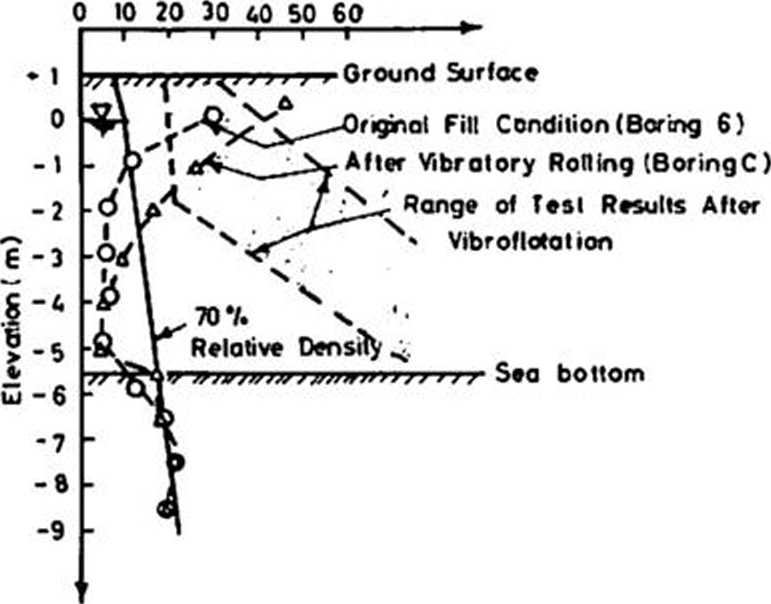6585844983
Israel
191
placement of the first meter of additional fili. This initial settlement of the soil first meter was attributed to the action of heavy construction eguipment used in filling. It is of interest that if the site conditions were analysed for the E0
values, based on Fig. 5, a settlement of about 3 cm under the added load would have been predicted. It should also be noted that use of the modulus of subgrade reac-tion value8 from Fig. 8 underestimates the settlements. Thus this case shows that with careful selection of the method of analysis, the SPT values can be of help in predicting settlements.
The effectiveness of compacting the dum-ped fili in place is clearly shown by the SPT results in Fig. 10. The BOMAG roller
No of Blows S P T R

Fig. 10 - Effects of Surface Compaction and Vibroflotation as Measured by SPT Method.
appears to have increased the relative density to morę than 70 per cent in the upper two meters, but its influence di-sappeared towards the bottom of the fili. Hence, Vibroflotation was employed to en-sure compaction of the fuli depth, later corapleting the compaction of upper layers by the use of the heavy vibratory roller. Results of SPT determined after Vibroflo-taion are also shown in Fig. 10, giving values of N corresponding consistently to morę than the 70 per cent relative density which was specified for construction control. Values of 5 showing morę than Dr = 90 per cent are not considered mea-
ningful, as has been commented upon by other investigators (Gibbs and Holtz, 1969).
Also of interest are the results of deter-mining the modulus of subgrade reaction k3Q on the fili by load testing with a
30 cm sąuare piąte on a surface just abo-ve water level. A value of about 35 kg/ cm* was indicated for the fili in its original condition, and values of several times as much were found after compaction.
Since the fili in all cases had been sub-jected to considerable traffic and densi-fication at this level, the load tests were not at all representative of the fuli depth of the layers. The moduli of subgrade reaction found were higher than could be predicted by the SPT correla-tions presented in this paper and would not be considered as directly applicable to prediction of settlement of enginee-ring structures at the site. Thus, pri-marily the parameters derived from SPT results appear to be most suitable for design.
CONCLUSIONS
1. The main method of penetration testing used in Israel is the Standard Penetration Test (SPT), as proposed by Ter-zaghi and Peck and standardized by the ASTM. It has been found essential to spe-cify use of a trigger mechanism to control the height of drop of the falling weight, so that fuli energy may be consistently obtained.
2. The SPT method is ordinarily specified for sandy materiał and soft rocks. Site investigation programs usually re-quire other methods, in particular field vane tests, to be used for evaluating co-hesive materials. The Dutch Cone Pene-troraeter has been successfully employed in some project investigations for evalu-ating the extent and thickness of soft strata.
3. The SPT data are interpreted with the use of corrections for overburden pressure to give estimates of relative density. Correlations of relative density with a friction angle, 0, modulus of subgrade reaction, k, and a soil modulus of elasticity, E,/have been suraraarized
in graphical forfi for use in design. Selection of an allowable bearing capacity and the prediction of settlement are based on this approach.
4. The SPT method has been found useful in special cases, such as revealing loose sand layers interbedded between soft sand-stone layers.
5. Construction control reguirements have been based on the use of SPT methods to verify successful compaction of sandy materials.
6. It is suggested that futurę research and studies be aimed at the following targets:
a. To develop penetration testing apparatus which would allow evaluation of the in-situ properties of both cohesive and granular materials without change in eąuipraent or methods.
b. Improved correlations of SPT with relative density, ćind relative density with engineering properties.
Wyszukiwarka
Podobne podstrony:
Crochet Borders00 #118STrrCHES & NOTES Notę: Using only words to describe the placement of the h
78 (191) 5.2.2. Therapy for the interossei palmares. (Stretching of interosseus palmaris IV shown.)
Lost Highway$ Cognitive theories of narration 191 focus of the following analysis is therefore: What
DSC06971 Ryc. 191. Widok miejsca opracowania (2007) Fig. 191. View of the place of study (2007) Fig.
DSC06971 Ryc. 191. Widok miejsca opracowania (2007) Fig. 191. View of the place of study (2007) Fig.
CSG248 Personal Pronouns 237 The Placement of Indirect Object Pronouns with Commands, Infmitives, an
Fully-constructed unit before attachment to a Gunn source. Please notę the placement of the 1N9
Poor placement of switches and Controls, and illegible, inaccessible or poorly
Bibliografia 271 Chudecki Z., Duda L. Annual Losses of Chemical Components of the Soil in the Płonią
Bibliografia 273 Elements in the Soil Profile under the Influence of Irrigation. Pieriemieszczenije
278 H. Pondel Kaszubiak H. The Appearance of Free Phages of Azotobacter in the Soil. Pcl. J. Soil Sc
Bibliografia 295 Winter Wheat and Sugar Beets Grown of Soil on the Soil Formed from Loess. Ann. UMCS
Bibliografia 301 nija kalia w poczwie. Transformations of Potassium in the Soil. Pr. nauk. Instytutu
li4H. Pondel Grzebisz W., Kociałkowski W., Jean D. Effect of Changes in the Properties of Light Soil
17 Plant metaphors for the expression of emotions THE HEART IS THE SOIL. In this interpretation, dee
więcej podobnych podstron